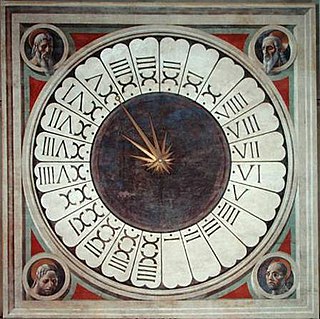
A clock or a timepiece is a device used to measure and indicate time. The clock is one of the oldest human inventions, meeting the need to measure intervals of time shorter than the natural units such as the day, the lunar month and the year. Devices operating on several physical processes have been used over the millennia.

A sundial is a horological device that tells the time of day when direct sunlight shines by the apparent position of the Sun in the sky. In the narrowest sense of the word, it consists of a flat plate and a gnomon, which casts a shadow onto the dial. As the Sun appears to move through the sky, the shadow aligns with different hour-lines, which are marked on the dial to indicate the time of day. The style is the time-telling edge of the gnomon, though a single point or nodus may be used. The gnomon casts a broad shadow; the shadow of the style shows the time. The gnomon may be a rod, wire, or elaborately decorated metal casting. The style must be parallel to the axis of the Earth's rotation for the sundial to be accurate throughout the year. The style's angle from horizontal is equal to the sundial's geographical latitude.
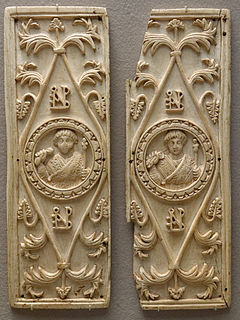
A diptych is any object with two flat plates which form a pair, often attached by hinge. For example, the standard notebook and school exercise book of the ancient world was a diptych consisting of a pair of such plates that contained a recessed space filled with wax. Writing was accomplished by scratching the wax surface with a stylus. When the notes were no longer needed, the wax could be slightly heated and then smoothed to allow reuse. Ordinary versions had wooden frames, but more luxurious diptychs were crafted with more expensive materials.

An astrolabe is an ancient astronomical instrument that was a handheld model of the universe. Its various functions also make it an elaborate inclinometer and an analog calculation device capable of working out several kinds of problems in astronomy. In its simplest form it is a metal disc with a pattern of wires, cutouts, and perforations that allows a user to calculate astronomical positions precisely. Historically used by astronomers, it is able to measure the altitude above the horizon of a celestial body, day or night; it can be used to identify stars or planets, to determine local latitude given local time, to survey, or to triangulate. It was used in classical antiquity, the Islamic Golden Age, the European Middle Ages and the Age of Discovery for all these purposes.
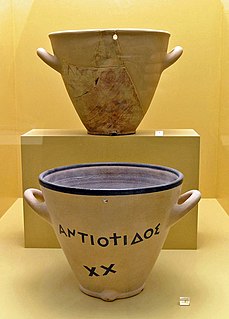
A water clock or clepsydra is any timepiece by which time is measured by the regulated flow of liquid into or out from a vessel, and where the amount is then measured.
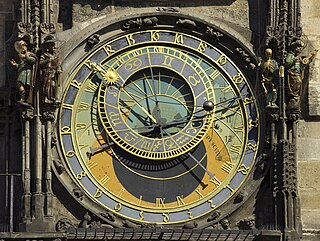
An astronomical clock, horologium, or orloj is a clock with special mechanisms and dials to display astronomical information, such as the relative positions of the Sun, Moon, zodiacal constellations, and sometimes major planets.
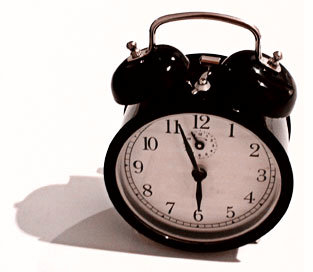
In sociology and anthropology, time discipline is the general name given to social and economic rules, conventions, customs, and expectations governing the measurement of time, the social currency and awareness of time measurements, and people's expectations concerning the observance of these customs by others.
Navigational instruments are instruments used by nautical navigators and pilots as tools of their trade. The purpose of navigation is to ascertain the present position and to determine the speed, direction, etc. to arrive at the port or point of destination.
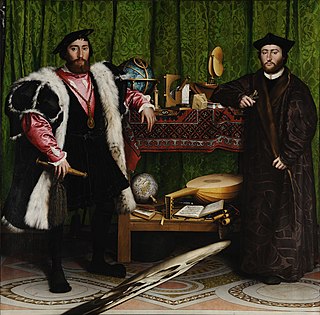
The Ambassadors is a 1533 painting by Hans Holbein the Younger. Also known as Jean de Dinteville and Georges de Selve, after the two people it portrays, it was created in the Tudor period, in the same year Elizabeth I was born. Franny Moyle speculates that Elizabeth's mother, Anne Boleyn, then Queen of England, might have commissioned the painting as a gift for Jean de Dinteville, the ambassador portrayed on the left in the painting. As well as being a double portrait, the painting contains a still life of several meticulously rendered objects, the meaning of which is the cause of much debate. It also incorporates one of the best-known examples of anamorphosis in painting. The Ambassadors has been part of London's National Gallery collection since its purchase in 1890.
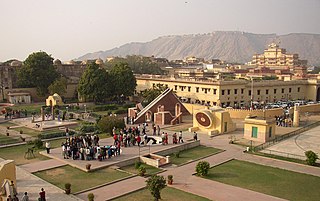
The Jantar Mantar, Jaipur is a collection of 19 astronomical instruments built by the Rajput king Sawai Jai Singh II, the founder of Jaipur, Rajasthan. The monument was completed in 1734. It features the world's largest stone sundial, and is a UNESCO World Heritage site. It is near City Palace and Hawa Mahal. The instruments allow the observation of astronomical positions with the naked eye. The observatory is an example of the Ptolemaic positional astronomy which was shared by many civilizations.

Jantar Mantar is located in the modern city of New Delhi. “Jantar Mantar” literally means “instruments for measuring the harmony of the heavens”. It consists of 13 architectural astronomy instruments. The site is one of five built by Maharaja Jai Singh II of Jaipur, from 1723 onwards, revising the calendar and astronomical tables. Jai Singh, born in 1688 into a royal Rajput family that ruled the regional kingdom, was born into an era of education that maintained a keen interest in astronomy. There is a plaque fixed on one of the structures in the Jantar Mantar observatory in New Delhi that was placed there in 1910 mistakenly dating the construction of the complex to the year 1710. Later research, though, suggests 1724 as the actual year of construction. Its height is 723 feet (220 m).
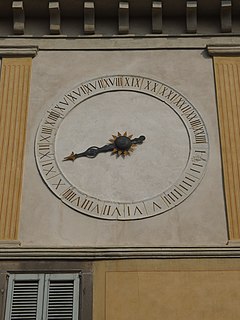
Clocks and watches with a 24-hour analog dial have an hour hand that makes one complete revolution, 360°, in a day. The more familiar 12-hour analog dial has an hour hand that makes two complete revolutions in a day.

Saracinesco is a comune (municipality) in the Metropolitan City of Rome in the Italian region Lazio, located about 40 kilometres (25 mi) northeast of Rome.

Nicholas Kratzer, also known as Nicolaus Kratzer and Nicholas Crutcher, was a German mathematician, astronomer, and horologist. Much of Kratzer's professional life was spent in England, where he was appointed as astronomer to King Henry VIII.
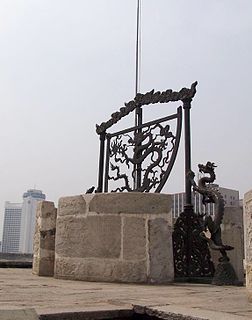
A quadrant is an instrument used to measure angles up to 90°. Different versions of this instrument could be used to calculate various readings, such as longitude, latitude, and time of day. It was originally proposed by Ptolemy as a better kind of astrolabe. Several different variations of the instrument were later produced by medieval Muslim astronomers. Mural quadrants were important astronomical instruments in 18th-century European observatories, establishing a use for positional astronomy.
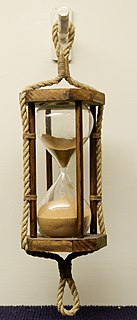
The history of timekeeping devices dates back to when ancient civilizations first observed astronomical bodies as they moved across the sky. Devices and methods for keeping time have since then improved through a long series of new inventions and ideas. Sundials and water clocks originated from ancient Egypt, and were later used by the Babylonians, the Greeks and the Chinese; medieval Islamic water clocks were unrivalled in their sophistication until the mid-14th century. Incense clocks, which may have been invented in India, were being used in China by the 6th century. The hourglass, one of the few reliable methods of measuring time at sea, was a European invention and does not seem to have been used in China before the mid-16th century.

Astronomical rings, also known as Gemma's rings, are an early astronomical instrument. The instrument consists of three rings, representing the celestial equator, declination, and the meridian.

A sundial is a device that indicates time by using a light spot or shadow cast by the position of the Sun on a reference scale. As the Earth turns on its polar axis, the sun appears to cross the sky from east to west, rising at sun-rise from beneath the horizon to a zenith at mid-day and falling again behind the horizon at sunset. Both the azimuth (direction) and the altitude (height) can be used to create time measuring devices. Sundials have been invented independently in every major culture and became more accurate and sophisticated as the culture developed.
Shadows is a software package for the calculation and drawing of sundials and astrolabes, available as a freeware in its base level.

Mishra Yantra is one of the four unique astronomical instruments of the Jantar Mantar observatory located in New Delhi, India. Each instrument at the Jantar Mantar are separate brilliant architectures constructed based on mathematical observations, and help in calculating different aspects of celestial objects and time. It is widely believed that the Jantar Mantar was constructed in the year 1724. The four instruments of Jantar Mantar are Samrat Yantra, Jay Prakash Yantra, Ram Yantra and the Mishra Yantra.

















